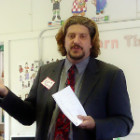 Last week, I sat with 20 other Out-of-School-Time (OST) professionals at the quarterly meeting of the California Afterschool Network’s Leadership Team. Support for Common Core in Out-of-School-Time was on the agenda, and the Network is applying for a related grant from the Mott Foundation. As I perused the grant description, something huge struck me: the grant’s objective is not to deliver Common Core support — it is to design and implement systems of delivery.
Last week, I sat with 20 other Out-of-School-Time (OST) professionals at the quarterly meeting of the California Afterschool Network’s Leadership Team. Support for Common Core in Out-of-School-Time was on the agenda, and the Network is applying for a related grant from the Mott Foundation. As I perused the grant description, something huge struck me: the grant’s objective is not to deliver Common Core support — it is to design and implement systems of delivery.
So much of what we do in education is akin to Sisyphus rolling that boulder up the hill with every new program and initiative, and then starting over when the next new shiny object flashes from the government or the education think tanks. With a system, all we would do is replace that rock with whatever is “new and improved,” and continue rolling it from our current place, rather than starting again at the bottom of the hill.
Most importantly, we need to preserve our collective knowledge of everything that came before. Think back to just the past few decades of OST/Education theory: Latchkey, Youth Development, 21st Century Learning Centers, NCLB, ASES, NSACA Accreditation, Desired Results, STEM, Common Core. No wonder we’re all tired of rolling the ball up the hill.
Any effective system must start with a knowledge base. OST professionals on the ground must have knowledge of what Common Core is, what its outcomes are, knowledge of the specific standards, and what the school is currently teaching. This requires intentional and effective communication with the school and access to professional development on the part of the OST professional.
Once the basic knowledge is in place, it is time to start thinking about the system of delivery, or in more familiar language, the practice.
Resting on the bedrock of knowledge, there are three pillars of an effective system of delivery. The first pillar is experiences. OST professionals are very good at creating experiences for youth: effective projects, games, and other experiential occurrences in OST must be pre-planned with a specific goal (or goals) in mind (in this case the Common Core standards).
The second pillar, environment, has to do with everything and anything that a child or youth can see, hear, touch or do during program time. Experienced OST professionals plan to optimize program participants’ physical space to allow for exploration and discovery using their senses. With forethought and intention, the environment can easily be in service of supporting the Core standards. The essential question that must be asked is: How intentional is your room/facility setup, and to what ends is it pre-planned with Common Core in mind?
The third pillar of delivery, relationships, is perhaps the most ineffable, and in my opinion, is the most important. Think about your own past education. Do you remember the excitement of learning about mitochondria in biology? Learning how to pitch a curve ball? Do you remember the thrill when you finally understood the causes of the Civil War? Of course you don’t. My guess is that you do remember the teacher or coach who made these things stand out. You remember your friends and teammates who were there to see you achieve the benchmark. In order to make any system of information delivery work, you need to take a long, hard look at your relationship with your students. You have to design a program where the children and youth in your program feel valued, respected, and, yes … even loved.
If your program does not have this pillar of rapport and relationship, then it doesn’t matter what system you are using to deliver your Common Core message.
The capstone to this system of delivery is purpose. Purpose is the essential partner to knowledge, and will shield your system of experiences, environment and relationships from the ravages of entropy and burnout.
So now that you have been asked to create Common Core supports in your Out-of-School-Time program, you have a choice. You can run, like Sisyphus, to the bottom of the hill and begin pushing again, or you can implement a system and let the momentum of your well-designed OST program transition you smoothly.
In the end, it is merely a choice between working harder and working smarter.
Rick Rood is a 25-year front-line veteran of the Out-of-School-Time profession and author of the book Games Teachers Play Before the Bell Rings.































